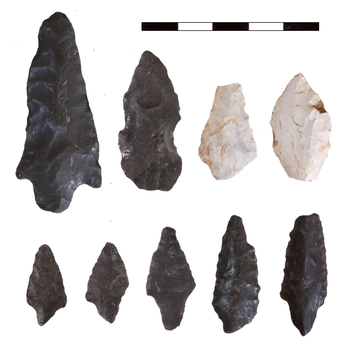The Antikythera Survey Project
Andrew Bevan, James Conolly, 2012. (updated 2014) https://doi.org/10.5284/1024569. How to cite using this DOI
Data copyright © Andrew Bevan, Prof James Conolly unless otherwise stated
This work is licensed under a Creative Commons Attribution 4.0 International License.
Primary contact
Andrew
Bevan
UCL Institute of Archaeology
31-34 Gordon Square
London
WC1H 0PY
England
Resource identifiers
- ADS Collection: 1115
- DOI:https://doi.org/10.5284/1024569
- How to cite using this DOI
Overview
Antikythera is one of the smallest (ca. 20.8 sq.km) and most remote inhabited places in the insular Mediterranean, but lies on along some important routes of maritime travel and transport between the Peloponnese and Crete, and between the eastern and central Mediterranean. The Antikythera Survey Project was interested in all periods of human activity on the island from the earliest indications in perhaps the 5th millennium BC through to the present day. At the core of this programme of research was an intensive pedestrian survey that is unusual for having covering an entire island in a uniform manner using intensive survey methods.

The datasets archived here represent the full and complete results from this survey and from the subsequent programme of artefact study. The artefact data has been subdivided into three discrete elements: 'pottery', 'lithics' and 'other', while the other spatial data section contains information about three kinds of survey: stage-one tractwalking, stage-two grid collection and separate surveys of geology, standing structures and terraces.
All ASP datasets provided via the ADS are licensed under a Creative Commons CC BY 3.0 license

At the time of deposition, one book and a range of published or forthcoming papers draw directly upon these datasets, as listed below.
References
Bevan, A., Conolly, J., Colledge, S., Frederick, C., Palmer, C., Siddall, R. and Stellatou, A. 2013. The long-term ecology of agricultural terraces and enclosed fields from Antikythera, Greece, Human Ecology 41.2: 255-272. DOI: 10.1007/s10745-012-9552-x.
Bevan, A., Conolly, J., Hennig, C., Johnston, A., Quercia, A., Spencer, L. and J. Vroom. 2013. Measuring chronological uncertainty in intensive survey finds. A case study from Antikythera, Greece, Archaeometry 55.2: 312-328. DOI: 10.1111/j.1475-4754.2012.00674.x.
Bevan, A. and Conolly, J. 2013. Mediterranean Islands, Fragile Communities and Persistent Landscapes: Antikythera in Long-Term Perspective, Cambridge: Cambridge University Press.
Bevan, A. and Conolly, J. 2011. Terraced fields and Mediterranean landscape structure: an analytical case study from Antikythera, Greece, Ecological Modelling 222: 1303-1314. DOI:10.1016/j.ecolmodel.2010.12.016.
Bevan, A. and Conolly, J. 2009. Modelling Spatial Heterogeneity and Nonstationarity in Artifact-Rich Landscapes, Journal of Archaeological Science 36.4: 956-964. DOI:10.1016/j.jas.2008.11.023.
Bevan, A., Conolly, J. and Tsaravopoulos, A. 2008. The Fragile Communities of Antikythera, Archaeology International 10: 32-36. DOI:10.5334/ai.1007.
Conolly, J. and A. Bevan, forthcoming. Lithic technology and the early prehistory of Antikythera, Hesperia.
Johnston, A., Quercia, A., Tsaravopoulos, A., Bevan, A. and Conolly, J. 2012. Pots, Piracy and Aegila. Hellenistic Ceramics from an Intensive Survey of Antikythera, Greece, Annual of the British School at Athens 107:247-272. DOI:10.1017/S0068245412000019.
Quercia, A., Johnston, A., Bevan, A., Conolly, J. and A. Tsaravopoulos. 2011. Roman Pottery from an Intensive Survey of Antikythera, Greece, Annual of the British School at Athens 106: 47-98. DOI:10.1017/S0068245411000037.
Palmer, C., Colledge, S., Bevan, A., Conolly, J. 2010. Vegetation Recolonisation of Abandoned Agricultural Terraces on Antikythera, Greece, Environmental Archaeology 15.1: 64-80.DOI:10.1179/146141010X12640787648973.
Pentedeka, A., Kiriatzi, E., Spencer, L., Bevan, A. and J. Conolly 2010. From Fabrics to Island Connections: Macroscopic and Microscopic Approaches to the Prehistoric Pottery of Antikythera, Annual of the British School at Athens 105: 1-81. DOI:10.1017/S0068245400000368.










